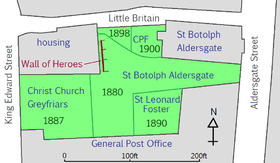Postman's Park
- This is London
- Nov 27, 2016
- 2 min read

Postman's Park is located in the ward of Aldersgate. Its name reflects its popularity amongst workers from the nearby General Post Office's headquarters. The park is built on three burial grounds. The park open in 1880 on the site of the former churchyard of St Botolph's Aldersgate church and grew over some years to incorporate the burial grounds of Christ Church Greyfriars and St Leonard. You'll notice that the park is raised from the pavement. This was raised due to there being a general lack of burial space in London that meant graves would be frequently reuseds, which led to bodies often simply being stacked on top of each other and covered with a layer of earth. By the mid-19th century, the ground level of the St Botolph's Aldersgate Churchyard was 6 feet (1.8 m) above that of the Christ Church Greyfriars burial ground, and 4 feet (1.2 m) above that of the St Leonard, Foster Lane, burial ground. With the churchyards and burial grounds no longer used for new burials, in 1858 it was decided to convert the churchyard of St Botolph's Aldersgate to a public park. Progress in clearing and covering the burial ground was slow, and it was not until 28 October 1880 that the churchyard was reopened as a public park. Laid out with flower beds and gravel paths, the park became a popular place for local workers to spend breaks. In 1887, the burial ground of Christ Church Greyfriars was given to the parish of St Botolph's Aldersgate. The burial ground was cleared and the ground level raised by 6 feet (1.8 m) to allow its incorporation into the new park. At this time, the burial ground of St Leonard, Foster Lane was also cleared and raised to integrate it with the new park, although it was not formally merged with the park until 1890. In 1900, the park became the location for George Frederic Watts's Memorial to Heroic Self Sacrifice, a memorial to ordinary people who died while saving the lives of others and who might otherwise be forgotten, in the form of a loggia and long wall housing ceramic memorial tablets. Only four of the planned 120 memorial tablets were in place at the time of its opening, with a further nine tablets added during Watts's lifetime. Watts's wife, Mary Watts, took over the management of the project after Watts's death in 1904 and oversaw the installation of a further 35 memorial tablets in the following four years along with a small monument to Watts. Later she became disillusioned with the new tile manufacturer and, with her time and money increasingly occupied by the running of the Watts Gallery, she lost interest in the project, and only five further tablets were added during her lifetime.





















































Comments